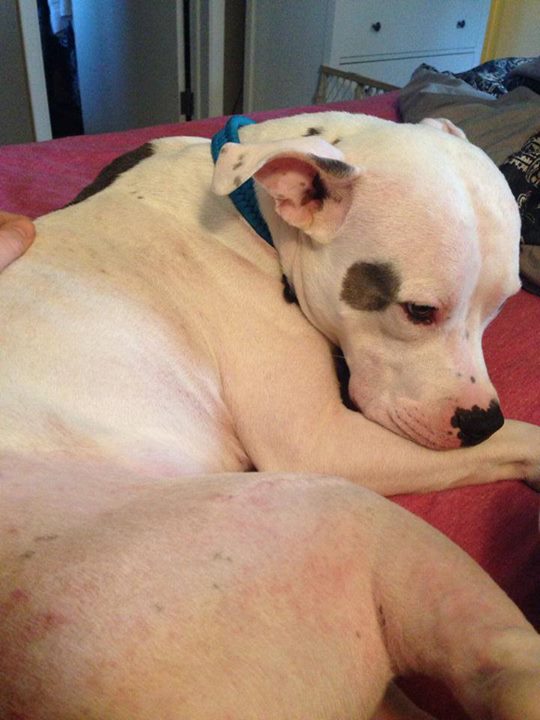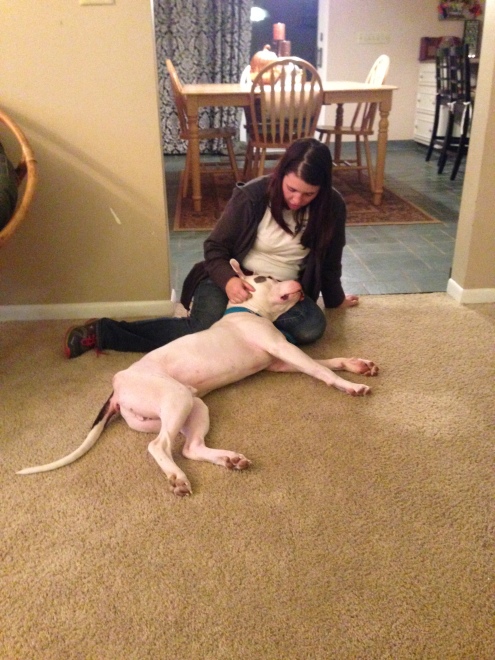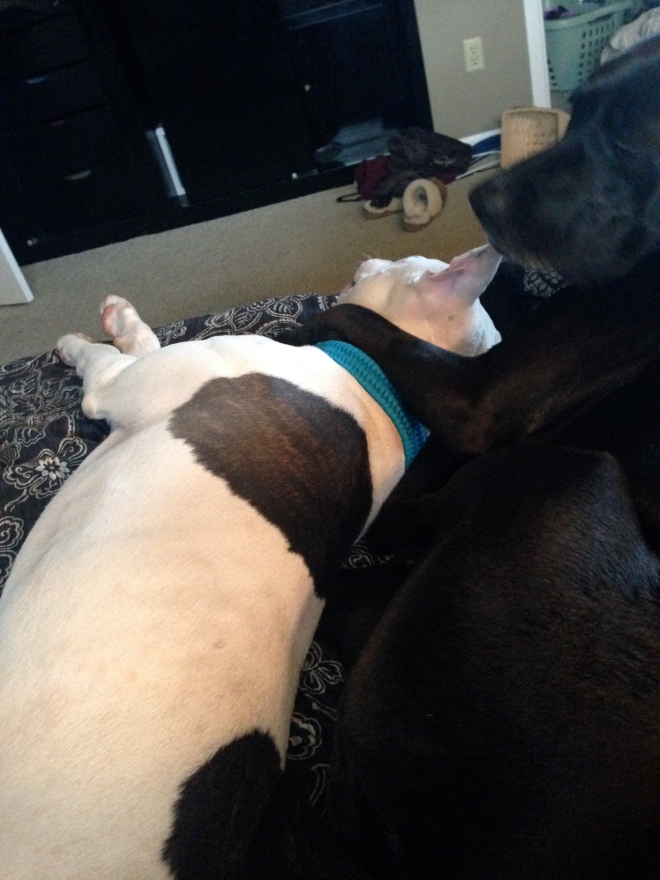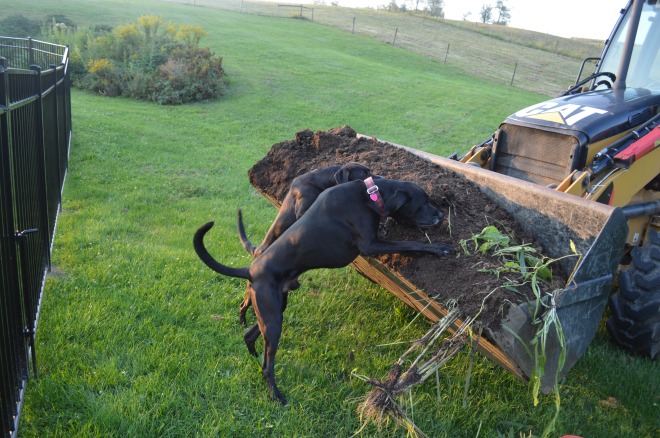…and not lose your marbles (or your spouse) in the process!
(Scroll to the bottom if you don’t care to read about our experience, and would rather check out our list of tips!)
 It is no secret that Kingston has dealt with separation anxiety since he first came to live in the AFM5 household. Perhaps he had some sort of constant companionship where he lived previously, or maybe he just thinks we are so fantastic that the thought of being apart from us sends him into a panic. We can’t say for sure the origin of this issue, but panic he does, and our house suffers most for it.
It is no secret that Kingston has dealt with separation anxiety since he first came to live in the AFM5 household. Perhaps he had some sort of constant companionship where he lived previously, or maybe he just thinks we are so fantastic that the thought of being apart from us sends him into a panic. We can’t say for sure the origin of this issue, but panic he does, and our house suffers most for it.
If you’ve never dealt with a dog who had issues with separation anxiety, then count your shimmery, shiny, (undamaged) lucky stars because it is NOT fun, not for anyone involved. And it’s not just the property damage, the expense, or the grumpy husband… it’s also the awareness that just your absence sends this animal into a state of sheer panic. Couple that with the fact that this pup is planned as only a temporary addition to your family, and you can understand why things get so complicated.
Some of you may remember that nothing about Kingston’s arrival was planned. I was contacted by someone who knew of his abuse, but couldn’t help or get him the medical care he needed. Of course there wasn’t much thought involved… I needed to do whatever I could to assist him. But when you are on emergency time, you aren’t exactly setting yourself up for success. When I finally got Kingston safeuly into our home, we were at a loss as to where to put him. We knew he wasn’t crate-trained, and we planned to practice a two-week de-stress, which would require that he stay separate from the rest of our animals. He seemed pretty quiet and lethargic, but we were told that he was a puppy, and we all know that puppies chew. So we set up our small, finished basement for him to be as comfortable as possible. We included a cozy bed, water, and plenty of toys. The first time we left him was for a few hours the day we brought him home. I know, not ideal, but remember that this wasn’t part of a ‘plan’ and we do have other commitments. We came home to a few ‘accidents,’ but no property damage, so we chalked it up to a house-training issue.
For the first few days, the worst thing Kingston did was panic DURING our departures, and force his way through the door as we tried to exit. Thankfully when he ‘escaped,’ he didn’t go far, considering that his destination was simply wherever I was. However, this repeated dance was anxiety-inducing for all of us.
To solve this problem, I worked on training a ‘stay’ with Kingston. He couldn’t ‘sit’ so well, due to the femur break, so it was a nice way for us to bond over some simple obedience. This worked well for the physical act of leaving, but it was at this point that he began performing custom carpentry… see below for evidence.
 Note: actual removal of door frames
Note: actual removal of door frames
At this point, it became clear that I needed to dedicate myself to crate-training Kingston. In the past, we had always crate-trained our dogs, even in my childhood, and they had all treated their kennels as their ‘dens’. I had never had a dog that gave me an issue with relaxing in their crate. Nevertheless, I took the process slowly. At first, Kingston was only expected to eat his meals or treats in his kennel, and with the door open. Slowly but surely, I began closing the kennel door and sitting with him for short, increasing increments of time. He was always relatively calm at these times, but the second I walked away, he became a dinosaur.
 No, seriously.
No, seriously.
The noises, guys. I wish I could relay them in picture-form. If we had neighbors, they would rank it somewhere between a puppy-torture chamber, and the return of Jurassic Park. Add that to the rocking-and-rattling of his kennel (he flipped it more than once) and you would have about 1% of the noise that this dog created.
It was at this point that we realized we needed to step up our game. We tried Kongs, food puzzles, Rescue Remedy, the Thundershirt, Happy Traveler treats, and DAP diffusers, all to varying levels of success, but nothing hit the ball out of the park.

Disclaimer: This happened while wearing his thundershirt, sniffing the DAPs, absorbing the remedies, and letting his foster sister out of her kennel…
As gradually as I tried to proceed with the crate-training for Kingston’s sake, at one point I was given advice that I was taking it too slowly. It was at this point that I added 3 carabiner clips to his kennel, and left him. For approximately 30 minutes. When I came home, it was to a totally dismantled kennel and a very. bloody.dog. outside of said kennel. Not fun, not for anyone. (I will not share those photos, you can thank me later.)
At this point, I was advised by that same person to visit our veterinarian for anxiety medications, and so we made an appointment with the vet. She seemed to be unfamiliar with medicating for anxiety issues, but prescribed Kingston with Prozac. The very first day I gave this to him, all was well. It didn’t seem to have any affect on his anxiety, but it is said that these medications can take weeks to work. However, that night I was awoken multiple times within every hour by a dog who would.not.stop.itching. I panicked that his fleas had returned, but closer inspection (light ON) revealed a dog truly covered in hives. We’re talking no less than one hundred red, inflamed, itchy bumps all over little K’s body, from the top of his head to his twinkly toes and his tail! Truly the ONLY thing that had changed in Kingston’s environment was the medication.

I decided that it was time to call in a professional trainer. The vet had been little to no help, and I knew that even if we were able to find a way to manage his anxiety, it would probably flare whenever he went to his new home. I wanted to be sure that the steps I was taking were correct, so that I could arm his new family with the proper tools to ensure success.
I will spare you the drama that ensued, but it was then outright stated that by me not immediately choosing a second medication (I didn’t know which one to pick, neither did the vet, and I was worried about another allergic reaction. ‘Let’s just spin in a circle until we land on one to try,’ is not my preferred method of veterinary treatment. Sorrynotsorry.) that I was neglecting Kingston and his condition. OH hailnaw, ain’tnobodygottimefo’that. Thankfully, I reached out to Beth McGonigal, force-free dog trainer extraordinaire, and I am so glad that I did. (Thank you to A Positive Promise and all of you who donated funds for helping to make this possible!)
The first thing Beth asked was for me to give her a detailed list of the ‘symptoms‘ of Kingston’s anxiety, or what I saw that, to me, equaled anxiety. This is the list I gave her:
- Excessive drooling
- Shaking, trembling
- Strange vocalization (not barking)
- ‘Velcro-dog’
- Won’t eat
- Destruction of doors and doorframes
- Some urinating/defecating
Beth also asked what we have done to try to combat the issues, and you can see this list below:
- Calming Music
- Bach’s Rescue Remedy (natural herbal anti anxiety)
- Crate training (panics more)
- Frozen filled kongs
- Thundershirt
- Prescription anti-anxiety meds (allergic reaction)
- Training (leaving him alone for short amounts of time, rewarding quiet behavior, extending the amount of time he is alone by small increments, etc)
- Baby gates instead of closed doors
- Leaving another dog with him (while both are crated)
- Food puzzles/treat dispensers to burn off some energy
Of that list, the only one that had a notable impact on his anxiety level was when we left Gaige with him. However, he then directed his attention to breaking her out of her kennel, which he was successfully able to do on more than one occasion.
After coming to our home and evaluating Kingston, Beth gave us some great feedback on what we were doing right, where we could improve, and some new tricks to try. The most successful of those was to purchase an airline crate, in place of his current metal one. This has helped immensely, simply by Kingston learning that his attempts to break out are unsuccessful, and he is rewarded (by treats, praise, or freedom!) when he is calm and quiet in it. Beth also said that in her years of experience, she has only ever resorted to psycho-medications for ONE dog, and that pup would randomly attack inanimate (and also totally animate) objects to the death. So there’s that.

When in doubt, get a cat to keep your anxious dog company. That ALWAYS works.
While we are not at a point where Kingston’s anxiety is ‘cured’ (and we may never truly get there!) we can safely say that it is being properly managed. Here are some tips and tricks we’d like to share with all of you, many of which were inspired by the things we learned from Beth. She was gracious enough to allow us to share them with all of you (have we mentioned, she’s the best?!)

1. Analyze His Behavior
The first thing you need to do is properly analyze your pup’s behavior, in order to identify their triggers. When are they displaying these behaviors? Is it only when a specific person leaves, or anytime they are alone? If the behavior occurs due to a specific person(s) leaving, this is termed Separation Anxiety. However, if it occurs whenever alone, it is actually referred to as Isolation Distress. In Kingston’s case, even in the presence of the trainer, he still exhibited mild to moderate anxiety when Foster Dad and I left the room. Therefore, his behavior can accurately be termed Separation Anxiety. However, as he is also more comfortable with Gaige in the room as opposed to being totally alone, he also has Isolation Distress.
While analyzing their behavior, write down the list of ‘symptoms’ you see, as I did above. This will help you or a training professional to identify the severity of the anxiety, and therefore an appropriate treatment plan. Our trainer identified Kingston’s SA as mild to moderate, and his ID as moderate to severe.
2. Research & Modify the Environment
Using our tips above, books, or even just the handy-dandy google search, come up with some approaches that have worked for other owners in dealing with SA and ID. If you have a dog with ID or SA, you have probably already modified the environment in some way. You should ensure that they are safe, even if they were to escape from their crate or kennel. This means putting up anything hazardous or dangerous.
One reason some dogs exhibit SA/ID is due to lack of enrichment in their environment. By providing them with various sounds, smells, etc you can sometimes relay the anxiety. In addition to the ones I have listed above, you can try these below:
- Sound/Sight: Experiment with TV vs classical music, etc.
- Sight: Having access to a window may help some dogs, while it may make the anxiety worse for others.
- Sight: For some dogs, it is simply the element of the closed door that causes the panic. In this instance, try utilizing baby gates or other similar barriers. You may also try placing the dog’s kennel in an area where they are unable to see you leave.
- Sight: Lights on vs. lights off or blanket covering the kennel.
- Smell: Leaving the dog with a piece of worn clothing that smells like the owner
- Smell: DAP (Dog-Appeasing Pheromone). These are wall plug-ins (diffused) or collars (concentrated) that give off pheromones similar to the ones a lactating female dog would produce, which calms dogs under stress.
- Touch: Constricting jackets like the Thundershirt have been shown to calm some dogs.
- Taste: Some dogs do better when left with food or other yummy treats like a Kong or special bone.
Other things to try:
- I would personally always recommend enclosing an anxious dog in a kennel of some sort. This is as much for their safety as it is for the sake of your home. A plastic airline crate is not only more durable and escape-proof, but it also can offer a more den-like environment for some dogs, as opposed to the cage-like metal kennels. Try to make their kennel as comfortable and appealing as possible.
- Burn off energy: this can be as straight-forward as a run or walk before you leave the dog alone, or more creative like utilizing treat-puzzles and other enrichment.
- Medication: Perhaps for some dogs, medication is a necessary option. However, it can’t hurt to at least try herbal remedies, such as Bach’s Rescue Remedy or Happy Traveler treats. If conventional medication is the avenue you’d like to try, simply be sure to consult regularly with your vet on any changes in your dog’s physical or mental state.
- Companionship: If you have another pet who is more calm and balanced, and if the two animals share a mutually-positive relationship, experiment with leaving them in some sort of proximity to one another. Note: I never recommend leaving any animals, even the most cohesive, free in a home when no one is there to observe. Of course this is just my personal opinion, but I think that doing so needlessly opens up the possibility of a scuffle, fight, injury or other issue.
3. Record the Results and Utilize Training
Experiment with the various options above, and others you may have gathered, first by utilizing them when you are home. This not only allows you to observe any changes in behavior, but also allows the dog to acclimate to the new modifications while in your presence, which may make them more relaxed and accepting. You can then proceed to ‘pretending’ to leave, while observing or listening from behind closed doors. Eventually you will be able to truly leave for short durations, and slowly increase the length of your time away from the home. Be sure to record what works in order to refer to it later, or share with your trainer!
If you have graduated to leaving your dog alone from any distance or for any length of time, only return when the dog is displaying appropriate behavior (no vocalization or destruction). This is their reward for behaving correctly!
Important: While some say that a schedule is crucial for dogs with anxiety, I could not disagree more. The best thing you can do for your anxious dog is vary your schedule and the length of time spent away from the home. This shows them that no matter how long you are gone, that you will always return, and they will gradually begin to become comfortable during your absence. Vary the time the dog is left in the crate, even in the beginning, from 5 minutes to 30 seconds back to 5 minutes to an hour.
One thing that worked well for Kingston was crating him in the same room where Georgia and Gaige were crated. If he began vocalizing or misbehaving while the other dogs were quiet, we would let the girls out while leaving him kenneled. He began to recognize that appropriate behavior was rewarded, and soon followed suit.
4. Stay Positive
As frustrating as it can be to deal with your dog’s anxiety, and the destruction that may follow, try to stay positive. There IS a light at the end of the tunnel, even if it does require the help of your vet or the assistance of a trainer. Recognize that his or her anxiety, while certainly unnecessary, stems from some sort of fear or trauma. Remember that by becoming angry with your dog, you will only exacerbate their panic. Try to make your departures as positive and enjoyable as possible.
 101 Things to Do with a Box was a REALLY fun clicker-training game Beth suggested that we play with Kingston. I had played it once before with our service-dog-in-training, Carrie. It can work well for a dog with SA/ID, or any dog who could use a little extra confidence!
101 Things to Do with a Box was a REALLY fun clicker-training game Beth suggested that we play with Kingston. I had played it once before with our service-dog-in-training, Carrie. It can work well for a dog with SA/ID, or any dog who could use a little extra confidence!
5. Remember every dog is different
While it can be helpful to reach out to others for advice or support, don’t let anyone strong-arm you into trying something that you do not feel is right or necessary for your dog, especially if they aren’t there to witness the behavior firsthand. What works for other dogs may work for yours, but it is just as likely that it will not. No dog has the same genetics, cognitive abilities, coping mechanisms, early development, or environment. If you put your dog’s best interests first, you can be sure to identify a management program that works best for you and your family.
6. There is no ‘cure’
Remember that there is no magic cure for SA/ID. Rather, your goal should be to find a way to manage the behavior so that it inflicts the least damage on your lifestyle and environment, and of course, your dog. By setting up an environment in which your dog feels most comfortable (and I don’t mean a fancy dog bed!) they will begin to relax even in your absence, until you see the negative behavior regularly dissipating. This does not mean that the behavior is cured forever, so be aware that if the environment changes (move homes, go on vacation, etc) the behavior may reappear.
7. Reach out to a Trainer
If all else fails, please do not hesitate to reach out to a force-free trainer like Beth. Even if you have tried all of the above, they will still have a bag full of tricks to try. Not only that, but dealing with SA/ID can be very frustrating. It is nice to have someone there who can remind you of all you have done WELL! The right trainer truly creates a partnership that will ensure success in your household, and we can’t thank Beth enough for having done that for us.

Kingston & Beth
Beth McGonigal: North Pittsburgh Animal Behavior















































